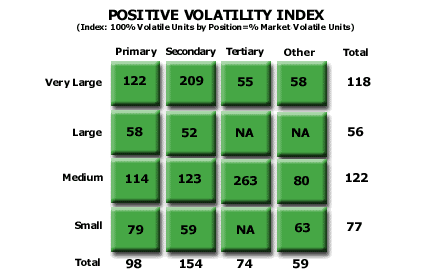BASIC STRATEGY GUIDE: STEP 6
Activity One (Steps 1-12):
Segment customers, both by size and by need, to identify targets for the Company.
Step 6: Find the annual amount and location of the industry’s Positive Volatility.

What:
Determine where on the Size/Role Matrix the industry’s Positive Volatility lies.
Volatility in the industry is market share that changes hands, from one set of suppliers to another. It also includes the purchase volume from customers entering or leaving the market place. Positive Volatility is that portion of industry volatility where:
-
Suppliers gain the purchase volume of customers who have entered the market, or
-
Where the suppliers displace some or all of the sales of another supplier who was supplying the customer.
Why:
The Volatility of any industry position on the matrix will often vary from the Volatility of the market as a whole. Along with the share growth of the Company’s customers, Positive Volatility is an important source of the company’s growth in market share. This step identifies the customer size segments with the highest rates of Positive Volatility, which may offer the company growth opportunities.
What to Watch For:
Depending on the number of customers entering or leaving the market, the industry’s Net Volatility may be either positive or negative. In many markets, Net Volatility is close to zero.
-
On the other hand, most companies have either a positive or negative Net Volatility.
In stable or developing markets, industry annual unit volatility ranges from 5% to 15% and averages about 10%. However, in Hostile markets, volatility is much lower, ranging from 2% to 5% and averaging 4%.
-
High volatility in the Primary Roles, especially with Very Large customers, indicates that Function and Price are important elements moving market share. These elements are important in Developing and Stable markets.
-
The more hostile an industry, the less likely that Function and Price move market share. As a result, in Hostile markets, the Primary Role with Very Large customers becomes less volatile than the market as a whole.
-
In Hostile markets, the Large and Small customers often have higher than average volatility as these customers believe that the industry suppliers are favoring their larger competitors, i.e., favoring Very Large at the expense of Large and Medium at the expense of Small.
Action:
Focus the Company’s efforts to gain share on those size segments where the industry’s Positive Volatility offers the most volume. Alternatively, the Company must develop new value propositions to create a level of Positive Volatility in some segments that exceeds what the industry has seen in recent years.
More Information on Industry Volatility on the Advanced Site>>
More Information on Volatility vs. Sales Growth on the Advanced Site>>
For helpful context on this step:
Videos:
Perspectives:
Symptoms and Implications:
